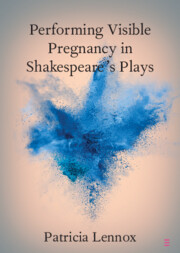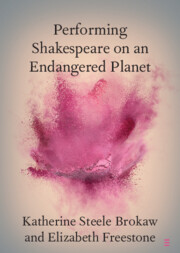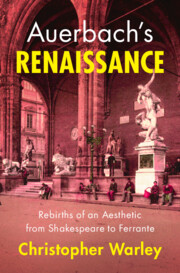Refine search
Actions for selected content:
307 results
Chapter 2 - Tricks of the Voice in King Lear
-
- Book:
- Voice and Ethics in Shakespeare's Late Plays
- Published online:
- 03 December 2025
- Print publication:
- 08 January 2026, pp 56-94
-
- Chapter
- Export citation
Chapter 3 - Seeing and Speaking in Pericles
-
- Book:
- Voice and Ethics in Shakespeare's Late Plays
- Published online:
- 03 December 2025
- Print publication:
- 08 January 2026, pp 95-127
-
- Chapter
- Export citation
Introduction - The Sound of the Voice
-
- Book:
- Voice and Ethics in Shakespeare's Late Plays
- Published online:
- 03 December 2025
- Print publication:
- 08 January 2026, pp 1-25
-
- Chapter
- Export citation
Chapter 1 - Bodies and Voices in Coriolanus
-
- Book:
- Voice and Ethics in Shakespeare's Late Plays
- Published online:
- 03 December 2025
- Print publication:
- 08 January 2026, pp 26-55
-
- Chapter
- Export citation
Chapter 4 - Phone and Female Mourning in The Winter’s Tale
-
- Book:
- Voice and Ethics in Shakespeare's Late Plays
- Published online:
- 03 December 2025
- Print publication:
- 08 January 2026, pp 128-156
-
- Chapter
- Export citation
Chapter 5 - Voicing Authority in The Tempest
-
- Book:
- Voice and Ethics in Shakespeare's Late Plays
- Published online:
- 03 December 2025
- Print publication:
- 08 January 2026, pp 157-204
-
- Chapter
- Export citation
Chapter 11 - ‘Art Thou Base, Common and Popular?’
- from Part III - ‘One of Us’
-
-
- Book:
- 'The People' and British Literature
- Published online:
- 11 December 2025
- Print publication:
- 11 December 2025, pp 175-188
-
- Chapter
- Export citation
Freedom and Politics in Shakespeare’s Cymbeline
-
- Journal:
- The Review of Politics , First View
- Published online by Cambridge University Press:
- 10 December 2025, pp. 1-19
-
- Article
-
- You have access
- Open access
- HTML
- Export citation

Voice and Ethics in Shakespeare's Late Plays
-
- Published online:
- 03 December 2025
- Print publication:
- 08 January 2026

Teaching Shakespeare’s Theatre of the World
-
- Published online:
- 21 November 2025
- Print publication:
- 18 December 2025
-
- Element
- Export citation

Performing Visible Pregnancy in Shakespeare's Plays
-
- Published online:
- 11 November 2025
- Print publication:
- 04 December 2025
-
- Element
- Export citation
8 - Applying Historical Phonology
- from Part II - Tracking Change in the History of English
-
-
- Book:
- The New Cambridge History of the English Language
- Published online:
- 23 October 2025
- Print publication:
- 23 October 2025, pp 224-245
-
- Chapter
- Export citation
16 - Shakespeare’s Language
- from Part II - Lighthouse Works and Authors
-
-
- Book:
- The New Cambridge History of the English Language
- Published online:
- 18 October 2025
- Print publication:
- 16 October 2025, pp 385-406
-
- Chapter
- Export citation
Chapter 8 - Michael Field and Verse Drama
- from Part II - Forms and Genres
-
-
- Book:
- Michael Field in Context
- Published online:
- 03 October 2025
- Print publication:
- 25 September 2025, pp 68-76
-
- Chapter
- Export citation
Making Something Out of “Much Ado About Nothing”
- Part of
-
- Journal:
- Public Humanities / Volume 1 / 2025
- Published online by Cambridge University Press:
- 23 September 2025, e138
-
- Article
-
- You have access
- Open access
- HTML
- Export citation
Introduction
-
- Book:
- The Will in English Renaissance Drama
- Published online:
- 04 September 2025
- Print publication:
- 18 September 2025, pp 1-31
-
- Chapter
- Export citation
Chapter 14 - The Epistemic Disobedience of Latinx Shakespeares
- from Part IV - Transcreating
-
-
- Book:
- Latinx Literature in Transition, 1444–1886
- Published online:
- 06 August 2025
- Print publication:
- 17 July 2025, pp 319-340
-
- Chapter
- Export citation

Performing Shakespeare on an Endangered Planet
-
- Published online:
- 02 July 2025
- Print publication:
- 24 July 2025
-
- Element
-
- You have access
- HTML
- Export citation

Auerbach's Renaissance
- Rebirths of an Aesthetic from Shakespeare to Ferrante
-
- Published online:
- 24 April 2025
- Print publication:
- 24 April 2025
Chapter 4 - The Mixed Style
-
- Book:
- Auerbach's Renaissance
- Published online:
- 24 April 2025
- Print publication:
- 24 April 2025, pp 90-115
-
- Chapter
- Export citation
